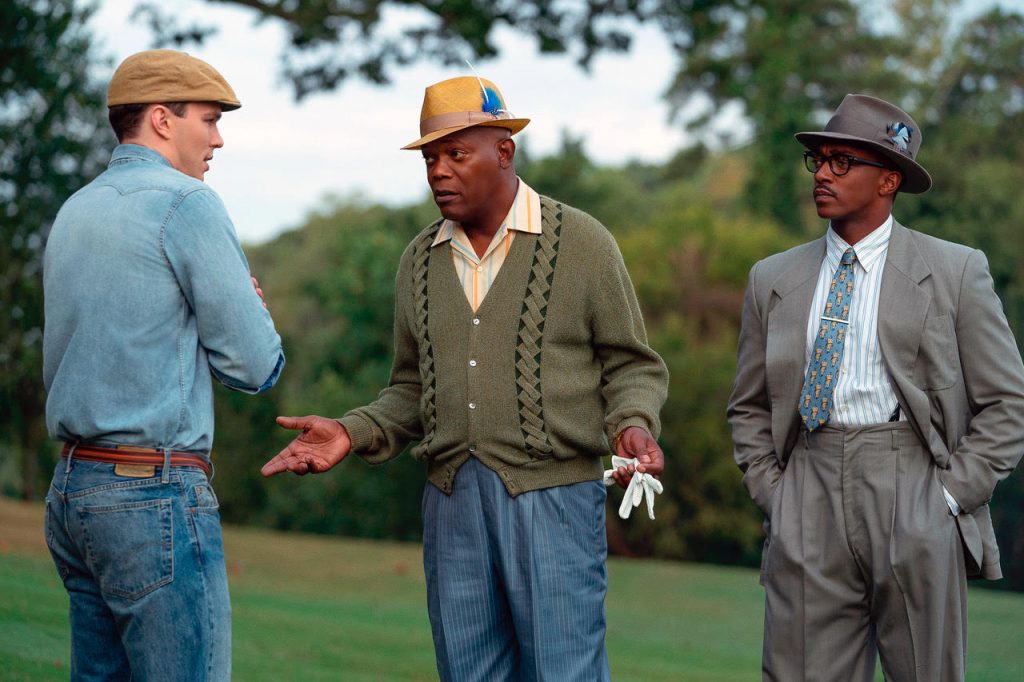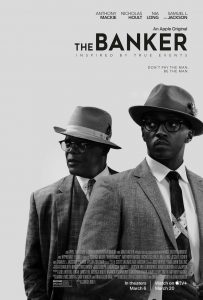
As it opens nationwide this week on Apple Plus TV, “The Banker” offers a dynamic look at an era from history that had a great impact on many but is still largely unknown. Inspired by the real relationship between Bernard Garrett (Anthony Mackie) and Joe Morris (Samuel L. Jackson), and their hired partner and protege Matt Steiner (Nicholas Hoult), “The Banker” may have some of the attractive beats of a buddy caper or a heist film. It’s highly watchable, but ventures beyond the tried and true into an important message about social justice that is still greatly needed in our society. Today, I share my interview with the film’s director and writer George Nolfi as we discuss the production of “The Banker” and why this story is so timely.
Synopsis:
In the 1960s, two entrepreneurs hatch an ingenious business plan to fight for housing integration–and equal access to the American Dream. (Courtesy of Apple TV+)
Q: Congratulations on “The Banker”. I loved the film and its important social messages. Please say a few words on how this project came onto your radar.
A: Joel Viertel, producer and editor of the film, pitched the story to Anthony Mackie and me when the three of us were working on my first film as a director, “The Adjustment Bureau”. I think Anthony and I both knew, right then and there, that we wanted to help get this story up on the screen. It’s just so extraordinary what the two men in this story actually did, and how they did it. It’s shocking to me that they were basically erased from history.
Q: “The Banker” is inspired by a true-life story of a dynamic team of groundbreaking individuals. How do you feel that Anthony Mackie and Samuel Jackson did at portraying the spirit of Bernard and Joe? What unique traits do their performances lend to this story?
Catch @LisaHendey interview with George Nolfi director of the new @AppleTVPlus original THE BANKER starring @SamuelLJackson @AnthonyMackie #TheBanker Share on XA: Well I developed and co-wrote the script specifically for Anthony and Sam and I think they both put in wonderful performances playing very different people. Bernard, from all the research we did — including eight hours of audiotapes of him telling his life story, extensive testimony before the US Senate, and an examination of a number of legal documents — really did seem to be a highly focused individual from a very young age. And he seemed to believe that if he just kept his head down and used his prodigious intelligence and determination that he could succeed, even in a system so badly rigged against him because of his race. And Anthony and I wanted to make sure we brought that out on screen. Joe Morris we have much less information on — we have what Bernard says about him — that he was fun-loving, exuberant, funny, and knew everyone. And the photos we have of him, along with the fact that he owned two highly successful jazz clubs in the 1950s certainly seems to support that. We also have Joe’s own testimony before the US Senate. All of that really pushed us to try to create a larger-than-life persona on screen, but also one who has an enormous amount of wisdom that comes out at crucial moments. I cannot think of a better actor working today to play those qualities than Samuel L. Jackson.

Q: While this is at its heart a Los Angeles story, principal production took place in Georgia? How challenging was it to locate properties that physically resembled those that Garrett and Morris would have purchased in the 1960s?
A: Yes, we shot mostly in Georgia, which had to stand in for rural Texas in 1939 and 1963-64 but also the US Capitol Building and a number of Los Angeles locations in the 50s and 60s. And it was extremely challenging. Luckily I was able to shoot three break-neck days in Los Angeles to round out certain things that really gave us that LA look.
Q: Speaking of the 1960s, congratulations on the production values here! What went into transporting us into the clothing, vehicles, and even the music of the 1960s?
A: What goes into that is hiring great department heads and really spending the time with them so that they can be in sync with my overall plan and creative “vision” for the film. Vision is a word I kind of hate but also one that I don’t know a better word for. That said, when clothing and production design and music are great and period-appropriate it is great primarily because of the work of those individual department heads and all the brilliant creative people they hire to bring the past to life.
Q: While “The Banker” has some of the fun of a heist film, there is an important social justice message at play. Why is this message so important in today’s world?
The systematic exclusion of African Americans from certain parts of the economic system is one of the main reasons that white families have twelve times as much wealth as black families. And there is still exclusion today.
Q: Please comment on Apple’s distribution of “The Banker”.
A: Unfortunately we ended up having our theatrical release just as COVID 19 hit the US. So some people who might have wanted to see the film on a big screen will not be able to. But that is such a tiny, insignificant thing compared to what this pandemic is going to do to so many in this country and the world overall. I pray for those who will suffer greatly at the hands of this scourge. Of course, many, many people will weather this period but be largely confined to their homes over the next four to twelve weeks. And thanks to Apple’s global reach millions of them all around the world will have immediate access to the film on Apple TV+. We start streaming the film on Thursday night.
Q: Are there any additional thoughts or comments you’d like to share?
A: I feel fortunate that this film has attracted the attention of Catholic Mom. Social justice was an important part of the religious tradition in which I was raised. And I have had an abiding interest generally in my work in the sorts of things that Christianity — and all the world’s great religions — try to help us think about and grapple with, the things that give our life the deepest meaning.
Stream “The Banker” at Apple TV+
Images courtesy of Apple. Used with permission
